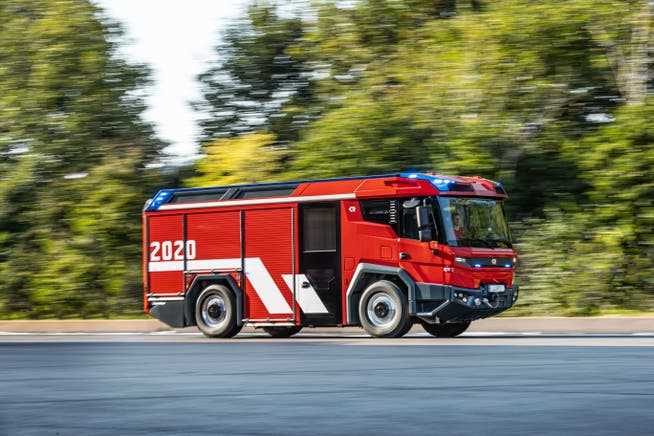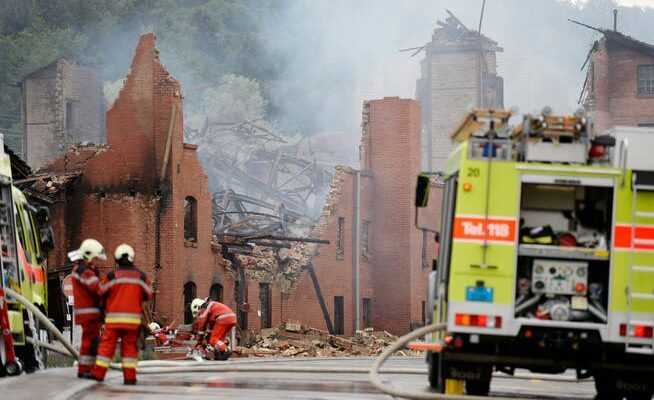Winterthur wants to be the first Zurich municipality to order a battery-powered fire truck. It costs around one million francs.
The price isn’t the only point of criticism.
The Winterthur fire brigade on a mission in 2015.
On the right is the E 20 tank tender that is now to be replaced.
There are fire departments that give their vehicles pretty names. Monika, for example. This is what they call the Dübendorf-Wangen-Brüttisellen fire department the turntable ladder. The commandant’s duty Skoda is called Gabriele.
In Winterthur they are a bit more sober in this regard. Their vehicles are all just called Eulach, like the river that crosses the city, or E. There is a number for it. E 20, for example, is a fire truck. And it is precisely about this E 20, or about its successor, that a dispute has broken out.
E 20 is a Mercedes truck from 1997. As is customary with heavy fire engines, it should be slowly sorted out and replaced after 25 years.
In the past, such a step would hardly have led to heated discussions outside the small circle of fire service experts. But the red-green governed city of Winterthur is currently in the process of replacing all municipal vehicles with more environmentally friendly alternatives at the end of their service life. This is what the Winterthur climate strategy calls for, and it also applies to the fire brigade.
The successor model of the E 20 is no longer only supposed to extinguish local flames, but also the world fire.
Basel is on fire for the new model
Alternative drives are not as well established in large and heavy motor vehicles as they are in cars. The Austrian industry giant Rosenbauer has now developed a tank tender that is causing a stir in the fire service scene. They call it the RT – the abbreviation stands for Revolutionary Technology.
The RT is a hybrid model. It is primarily operated by a battery; a diesel generator is only switched on for longer periods of use. In addition, the RT is designed as a tank fire engine from the axle to the roof ridge and not just a converted truck.
It’s a brand new, modern fire engine. It even has its own WiFi network and can be connected to drones flying over the source of the fire.

Battery-operated and one million francs expensive: the RT.
But like every revolution, the RT also has its price: A single vehicle costs around one million francs. At least that’s how much the canton of Basel-Stadt pays. The Basler had last September as the world’s first fire brigade completed a fleet order for the RT, with a delivery date of 2023. According to Surcharge transfer a total of 3.97 million francs for your four RTs.
One million for a fire truck: that is significantly more than for a standard variant. When the Kohlfirst fire brigade in the far north of the canton of Zurich ordered a conventional TLF in 2019, also from Rosenbauer, they paid around 430,000 francs, so just under half the price of an RT.
“Maybe we’d better wait a little longer”
The citizens of Winterthur in particular now do not understand why their city government relies on expensive solutions and technologies for which there is no long-term experience. The FDP and the SVP have submitted a joint interpellation to the local parliament, which puts a big question mark behind the purchase. There was also a request in the Zurich Cantonal Council.
The bourgeoisie is concerned with ecology, reliability and affordability. “Basically, I have absolutely nothing against electric and hybrid vehicles,” says Dieter Kläy. He is President of the Winterthur FDP and the parliamentarian who submitted the request for the E-TLF to the Cantonal Council.
“When a Spitex employee drives to her customers in an electric car, it makes a lot of sense. But does a tank pumper, which weighs tons, really need the same drive? “
In addition, one could ask whether Winterthur really needs to be the very first of the 162 Zurich municipalities to take this step. “I’m concerned with the costs, but also with the experience with the new technology,” says Kläy. Maybe it would be better to wait a little longer.
«Only for the city government’s photo album»
Urs Bänziger (fdp.) Is one of the initiators of the initiative in the Winterthur municipal parliament. From his point of view, it is not at all clear whether the bottom line is that the new, expensive TLF is actually that good for the climate.
The manufacture of a battery causes considerable CO2-Emissions, he throws in. The consequences of the degradation of rare raw materials that are needed for batteries should not be forgotten. These points are all the more important because a fire engine is only parked in the depot most of the time. The CO2– Savings in operation are therefore small.
“If the city is already spending money on climate measures,” he says, “then it should at least do it where it is most beneficial”. Bänziger is convinced that it would be more efficient «if, for example, oil heating systems in school buildings were replaced by heat pumps. An electric fire truck is primarily a measure for the city government’s photo album. “
Average driving distance: eight kilometers
The city officials see it differently. For them, the RT is not least a very good fire engine that “offers numerous functional advantages,” says Annette Hirschberg, spokeswoman for the Safety and Environment Department. “A fire engine on a conventional truck chassis does not offer that combined.”
The RT is already being used successfully in Berlin, training is taking place in Amsterdam, and many other metropolises, airports and factories are interested in the model. Part of the higher procurement costs can be amortized through lower maintenance and fuel costs. The TLF is fueled with its own solar power, Hirschberg continues.
The spokeswoman admits, however, that the mileage is not very high: a Winterthur TLF covers around 2500 kilometers per year, with an average driving distance of eight kilometers.
The building insurance is silent
That fire-fighting vehicles are no longer just over 400,000 francs
should cost, but twice as much, that is also an issue for the building insurance of the canton of Zurich (GVZ). She is on board with every purchase, and above all as a lender: the building insurance pays half of the purchase price, which is around 200,000 francs for a conventional TLF.
If she were to pay half of the price for an electric TLF from Rosenbauer, she would have to put around 500,000 francs on the table – more than a conventional vehicle costs in total. Would the GVZ want that? Is she even allowed to do that?
This is exactly what the Winterthur FDP President Dieter Kläy wanted to know from the government council in his question in the cantonal parliament. The building insurance is a state institution under the supervision of the canton.
The government did not give a clear answer. she just writethat it is premature to make statements about the amount of subsidies for an E-TLF because of the very high investment costs and the lack of practical experience.
Another sentence, however, makes you sit up and take notice: In its answer, the cantonal government emphasizes that a standard TLF can be procured for 420,000 francs that meets the requirements. It can also be read in such a way that anything that is invested beyond this is not necessary at all purely in terms of cantonal requirements.
So is an E-TLF for a million a luxury? The GVZ itself does not want to burn its fingers on this sensitive issue. She left a corresponding media inquiry unanswered and referred to the statements of the cantonal government.
Behind the scenes, however, there is much discussion at the GVZ. The Winterthur city administration is in any case informed about the next steps of the GVZ, as spokeswoman Annette Hirschberg says: “The GVZ will develop a vehicle concept including alternative drives by the end of 2022, within the framework of which the subsidy practice of vehicles with alternative drives will be examined.”
One thing is clear: at least technically, hardly anything speaks against the RT today. “The vehicle can basically meet the performance standards well,” writes the Zurich cantonal government. The building insurance company was able to test the vehicle last September. The Winterthur-based company was also able to put the model through its paces for two days, says spokeswoman Annette Hirschberg.
It will be a few years with or without RT before the Winterthur fire brigade actually goes out in a climate-neutral manner. Your latest fire truck, E 24, was only put into circulation in 2017. It will probably remain in the fleet until at least 2042.
According to the Zurich government, there are no other municipalities in the canton that also want to procure a battery-operated tank tender.
